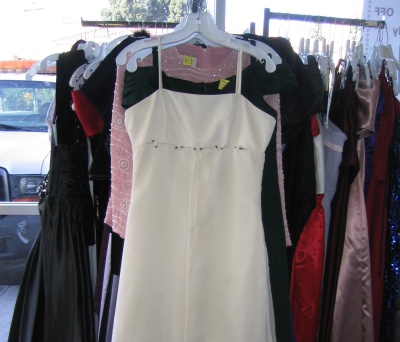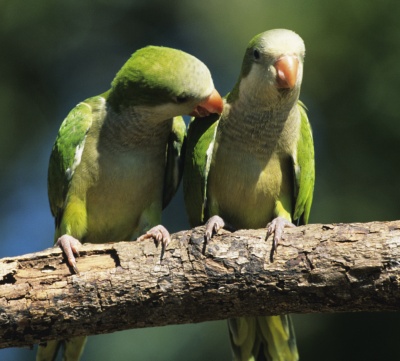 EARTH TALK: From the Editors of E/The Environmental Magazine
EARTH TALK: From the Editors of E/The Environmental Magazine
Dear EarthTalk: How or where can I recycle clothes that are too old or worn out for Goodwill? -- Tim Cheplick, Perrineville, NJ

Pre-owned clothes for sale at a Goodwill. What the organization doesn't sell retail it sends to "rag sorters." These textile recyclers then send the wearable clothing to developing countries and turn the unusable garments into industrial wiping and polishing cloths. (Photo: Arthaey, courtesy Flickr)
Just because that old shirt you used to love is too threadbare to wear anymore doesn't mean it has to end up in a landfill. "Consumers don't understand that there's a place for their old clothing even if something is missing a button or torn," says Jana Hawley, a professor of textile and apparel management at the University of Missouri-Columbia. "Ninety-nine percent of used textiles are recyclable."
Non-profits like Goodwill and the Salvation Army play a crucial role in keeping old clothes out of the waste stream. When they get donations of clothes that are too threadbare to re-sell in one of their shops, they send them to "rag sorters" that specialize in recycling pieces of fabric large and small. Says Hawley, these textile recyclers sell about half the clothing they get back overseas in developing countries, while unusable garments, especially cotton t-shirts, are turned into wiping and polishing clothes used by a variety of industries and sold to consumers. She adds that other textiles are shredded into fibers used to make new products, such as sound-deadening materials for the automotive industry, archival-quality paper, blankets and even plastic fencing.
Outdoor clothing and gear maker Patagonia, which plies a strong environmental mandate in key aspects of its operations (from sourcing of raw materials to managing waste to making grants to environmental nonprofits), in 2005 launched its innovative Common Threads Garment Recycling program. The program was originally begun so customers could return their worn out Capilene long undies for recycling, but has expanded to taking back Patagonia fleece and cotton t-shirts as well as Polartec fleece from other manufacturers. Consumers wanting to unload items that meet the program's criteria can do so at any Patagonia retail store or by mailing them into the company's Reno, Nevada service center.
Of course, do-it-yourselfers handy with needle-and-thread or sewing machines can turn their old clothes into new creations such as quilts, handbags and smaller items. The website Expert Village, which claims to have the largest online collection of "how-to" videos, offers a free series called "How to Recycle Old Clothes into New Fashions." Short step-by-step videos in the series cover such topics as transforming old garments into works of art; sewing patches, buttons and beads onto old clothes; deconstructing a wedding dress; ironing graphics onto old garments, and much more. Another good use for threadbare clothes (as well as sheets and towels) is pet bedding, whether in your own home or donated to a local animal shelter.
According to the non-profit Institute for Local Self-Reliance, textiles make up about four percent of the weight and eight percent of the volume of all municipal solid waste in the U.S. The commercial recycling company U'SAgain-which runs private for-profit recycling services in Atlanta, Chicago, Dallas, Minneapolis, Seattle, St. Louis and elsewhere-finds that some 85 percent of the 70 pounds of textiles the average American purchases each year ends up landfilled. That means the typical U.S. city with 50,000 residents has to pay (with local tax dollars) for the handling and disposal of some 3,000 tons of textiles every year. The shame of such waste is that textiles are so easy to recycle or otherwise find new uses for.
CONTACTS: Goodwill, www.goodwill.org ; Salvation Army, www.salvationarmy.org ; Patagonia, www.patagonia.com ; Expert Village, www.expertvillage.com ; U'SAgain, www.usagain.com .
Dear EarthTalk: What are the conservation implications of all the wild colonies of escaped pet parrots that have turned up in and around some major U.S. cities? -- Mike Gifford, Kirkland, WA

A pair of Quaker Parrots (also known as "Monk Parakeets") on a branch in Brazil, one of their shrinking native habitats. Preserving the health of the many wild flocks in the U.S. and other developed countries around the world may well be key to preventing these birds from going extinct altogether. (Photo: Getty Images)
At least three dozen different parrot species are now considered threatened or endangered in their quickly shrinking native tropical and sub-tropical habitats (mostly in South America). As such, the health of wild flocks in the U.S. and other developed countries around the world may well be key to preserving these birds that could otherwise go extinct.
Today wild parrot flocks thrive in urban and suburban areas of New York, New Jersey, Connecticut, Florida, Texas, Washington State and elsewhere. San Francisco and Brooklyn each host particularly large flocks, especially considering their relative lack of green space. Wild parrot flocks are also reportedly thriving in cities across much of Western Europe. Most of these parrots, of course, are not former pets themselves, but the descendents of birds that long ago may have escaped during transport from their jungle homes to pet stores generations ago.
Parrots are among the most intelligent and adaptable birds, so it is no surprise that they've done so well in North America and other regions, despite colder temperatures. Indeed it is not uncommon in the Northeast to see large groups of parrots perched in winter on deck railings piled with several inches of snow. The regions they inhabit, despite the cold weather, provide enough food and shelter to meet their relatively modest needs. And once the parrots were able to establish themselves in their new habitats, they got on with the business of breeding. Therefore, their offspring, though born in the city, are wild birds nonetheless, carrying on lifestyles not unlike those of their ancestors back in the jungles of South America (though their predators are different).
Conservationists are optimistic that the parrots' successful adaptation to more northerly urban environments bodes well for their future, despite the loss of much of their ancestral rainforest habitat. According to Roelant Jonker of the non-profit City Parrots, encouraging the formation of wild flocks of urban parrots promises to be a much more effective conservation tactic than trying to raise more birds in captivity where they would not so readily pass on their genes or learn the survival, adaptation and social skills necessary to survive. To Jonker, the proof is in the pudding: Some 2,500 wild red-crowned Amazon parrots (a quarter of the world's total) are thriving in and around California's biggest urban areas at the same time their population numbers are plummeting back in their native rainforest habitat.
The 2006 Judy Irving documentary, The Wild Parrots of Telegraph Hill, shadows wild parrot crusader Mark Bittner and his efforts to care for a wild flock of Red-headed Conyers living in San Francisco. Bittner feeds birdseed to the Conyers and gets to know each individual bird and its idiosyncrasies. The film's shots of parrots interacting with one another and with Bittner really drive the point home how much we have in common with the wild kingdom of animals all around us, whether we live in the city or the country.
CONTACTS: City Parrots, www.cityparrots.org; The Wild Parrots of Telegraph Hill, www.wildparrotsfilm.com.
GOT AN ENVIRONMENTAL QUESTION? Send it to: EarthTalk, c/o E/The Environmental Magazine, P.O. Box 5098, Westport, CT 06881; or e-mail: earthtalk (at) emagazine.com.


